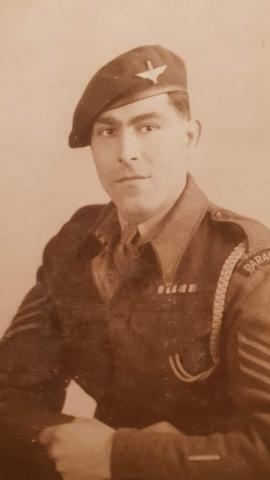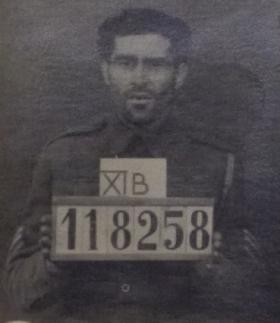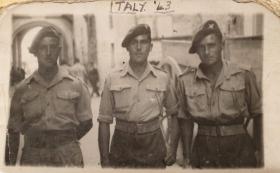Henry Raymond Beagle, always known as ‘Harry’, was born in 1917. Unfortunately his parents separated in 1919: “He was then fostered out to a number of different families in North London until the age of 14 when he was sent to Haddo House, a ‘Home for Working Boys’ in Kentish Town. By his own admission, the education he received as a young lad was sparse but maintained, nonetheless, that in a German PoW camp, the only useful words in a foreign language you needed to know were ‘hande hoch’ [hands up], ‘raus!’ [out!] and ‘kartoffel’ [potato].” [1a]
He enlisted into the Duke of Cornwall’s Light Infantry on the 3 April 1940. [1b]
‘Harry’ remembers one of the main reasons why he volunteered for Airborne Forces: “I was surprised to get mail from Ireland, as I was last there 1942/43 in the Duke of Cornwall’s Light Infantry, and apart from the scenery I thought it pretty miserable, in fact that was the reason I joined the para’s!” [2]
By now a Corporal, ‘Harry’ was on Parachute Course 63 at RAF Ringway, 4 – 17 May 1943. This was a ‘Long Course’ of eight descents – 1 x Night Balloon, 2 x Day Balloon, and 5 x Aircraft. His Parachute Instructors comments: “Erratic, but shows no hesitation”. All the men on this course were classed as reinforcements for the Parachute Brigades, and upon completion ‘Harry’ was sent to the 2nd Parachute Battalion, then stationed in North Africa. [3]
Here he was assigned to No 1 Platoon (commanded by Lt. A.M. ‘Tony’ Frank), which was part of ‘A’ Company, then under the command of Major RTH ‘Dickie’ Lonsdale, and it is likely that he took part in the parachute operation to capture the Primosole Bridge in Sicily on the 13/14 July 1943.
After the Sicily campaign the troops returned to North Africa, and then in September 1943, they took part in Operation ‘Slapstick’. This was to be a Divisional mission with the 2nd and 4th Parachute Brigade’s being transported on Royal Navy Cruisers into the port of Taranto in Southern Italy. The 1st Parachute Brigade and the 1st Air Landing Brigade would be in the Second Wave a few days later.
The 2nd Parachute Battalion returned to the U.K. in December 1943, and were billeted in the area around Grantham in Lincolnshire, with ‘A’ Company going to Easton Hall.
Lance Sergeant ‘Harry’ Beagle commanded No 2 Section of 1 Platoon, which was under the command of Lieut Robin Vlasto, at the Battle of Arnhem.
He parachuted onto DZ ‘X’, near Renkum in Holland, on Sunday, 17 September 1944 as part of Operation ‘Market’.
Along with the rest of the Battalion he reached the R.V. (Rendezvous Point), alright and his Platoon then get the order to move off, Lieut. Robin Vlasto: “14.39 hrs. At this time the general impression is pretty good and all the Huns seem to have cleared out of the neighbourhood in a hurry. All the Dutch people rush out of their houses and are obviously only too anxious to help, but they all have different stories about the Huns moving towards Arnhem that morning. Very disorganised, but incredibly friendly. “Move off” from Digby and I bring the Platoon in and give out orders for the march, 1 Section leading with Sgt [Beagle].” [4]
When they reached the railway underpass, near the Lower Oosterbeek Station on the Bendendorpsweg, they came under fire from an armoured car and at least one sniper. Lt Robin Vlasto: “Move off and almost immediately a Dutchman informs us there are a few snipers round about the station and houses. They fire at us, but are very soon cleared away by using a section covered by fire of another section. Go under the railway; the leading section has just [got] round the bend beyond the bridge, when an ‘Arc’ (Armoured Car) comes round the corner and takes us completely by surprise. Plays hell with its 20mm and MG Two men go down straight away on either side of me, which certainly brings us down to earth with a jolt. Sgt Ballinger goes back with his hand smashed up, Pte Gibson and PIAT killed.” [4]
Private. Thomas Gibson was a member of Harry’s Section and was the first fatality in the Platoon.
Eventually, after several minor skirmishes along the way, the Platoon reached the area of Arnhem Bridge, and they occupied a building right next to the North-western side of the high structure. Lieut. Vlasto placed a Section on each floor of the building and their PIAT operator proceeded to fire on the German pill-box situated on the Bridge.
Over the next four days the fighting was savage and the perimeter the 2nd Parachute Battalion, and attached units, were holding gradually dwindled to nothing and they were overrun.
‘Harry’ never talked much about the battle, but did leave some brief memories of his experiences: “I find it hard to recollect with any degree of accuracy other than arriving at the Bridge, being wounded and the subsequent time as a P.O.W., of which I am not very proud. Believe me, there was considerable confusion at the end of the Bridge – street fighting is a confused action, as you probably have been trained to expect – so I doubt very much if there ever will be a non-confused account of that part of the battle.” [5]
‘Harry’ was wounded and taken prisoner, probably on the 20 September 1944. Initially he was sent to the Willem III Kazerne (Barracks) at Apeldoorn, still in Holland, which was being set up as an improvised hospital for all the wounded – it became known as the ‘Airborne Hospital’. He left there with a party of walking wounded on the 3rd October 1944, and was transported to a POW Camp in Germany. This was Stalag 11B, at Falingbostel and he was given the POW No 118258; on 24th October 1944, he was transferred to Stalag VIIIc in Sagan. On 8th February, 1945, the occupants of Stalag VIIIc started their forced march westwards, away from the advancing Russians.
‘Harry’ was released from Regular Army Service to the Z/T/ Reserve on the 21st June 1946. [7]
‘Harry’ Beagle died on the 13 June 1999.
NOTES:
[1a] Details from Rae Byrne. December 2020.
[1b] & [7] Parachute Regiment Transfer & Enlistment Book 9, page 8.
[2] Letter from Harry Beagle to Bob Hilton. 15 January 1996.
[3] R.A.F. Ringway Parachute Course Report. May 1943.
[4] Lieut. Robin Vlasto personal account, written in POW Camp.
[5] Letter from Harry Beagle to Bob Hilton. 5 August 1996.
[6] Medical Records of 1st Airborne Division. Apeldoorn. 1944.
Created with information kindly supplied by Rae Byrne and Bob Hilton
Read More



Latest Comments
There are currently no comments for this content.
Add Comment
In order to add comments you must be registered with ParaData.
If you are currently a ParaData member please login.
If you are not currently a ParaData member but wish to get involved please register.